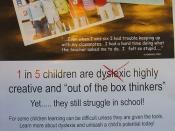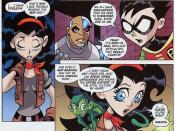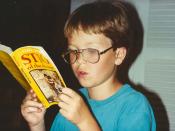The special need that I decided to research is Dyslexia. 'Dys' means 'difficulty' and 'lexia 'means 'words'. Dyslexia is a disorder that affects millions of people all over the world. It is one of several distinct learning disabilities that affect a person's ability to read. It is a specific language-based disorder characterized by difficulties in single word decoding, usually reflecting not enough phonological processing skills. It is unclear as to what causes dyslexia, but some research has come up with at least two causes. One is by inherited factors and the other by hearing problems at an early age.
Some of the well-known symptoms of dyslexia are the confusion over the direction letters face, difficulties with left and right, problems with keeping organized, spelling, and missing out words when reading. Dyslexics often have difficulties with concentration, memory, verbal skills, abstract reasoning, hand-eye coordination, poor grades, and underachievement.
Often, people with Dyslexia are considered to be lazy, rebellious, class clowns, unmotivated, misfits, or of low intelligence.
These misconceptions, without understanding dyslexia's effect on the person's life, lead to rejection, isolation, feelings of inferiority, discouragement, and low self-esteem. The truth is that a dyslexic learns at his/her own level and pace, and typically excels in one or more other area.
I am sure that there are many different teaching methods for those with dyslexia, but looking through many websites, I have found that two of them stuck out to be the most effective. One is a multi-sensory teaching method, and the other is an approach that involves confidence building.
Many studies have shown that a multi-sensory teaching method is the most successful approach for children with difficulties learning to read. This approach involves helping a student to learn using more than just one of his/her senses. In most classrooms, the only senses...


